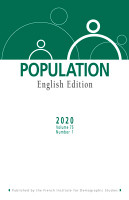
Population 2020, n°1
2020
Fertility Differences by Education in Britain and France: The Role of Religion
Nitzan Peri-Rotem
Immigrant Employment Trajectories in France, 1968–2008: a Sociohistorical Approach
Pierre Blavier et Anton Perdoncin
Social Transformation of the Paris Agglomeration in the 20th Century: a Longitudinal and Cohort Approach to Inequalities of Access to the City
Guillaume Le Roux, Christophe Imbert, Arnaud Bri ngé, Catherine Bonvalet
The First World War and the Disappearance of Surnames in France: a Trial Estimation Based on the Galton–Watson Model
Pierre Darlu, Pascal Chareille
Fertility Differences by Education in Britain and France: The Role of Religion
Nitzan Peri-Rotem
Female education is generally associated with lower fertility and higher rates of childlessness. However, it remains unclear whether higher education implies similar fertility behaviour among women of different religious denominations at varying levels of religiosity. To assess whether this is the case, this study uses data from the British Household Panel Survey and the French Generations and Gender Survey to explore the intersection of religion (measured by religious practice, Catholic affiliation in France, and Protestantism and Catholicism in Britain), education, and fertility outcomes for women born between the 1920s and 1960s. In Britain, higher education reduces the odds of entering motherhood more often among religiously unaffiliated women compared to nominally and practising religious women, although no such interaction effect is found in France. However, religiosity in both countries attenuates the negative relationship between education and completed family size. While unaffiliated women have a negative educational gradient of fertility, this study finds a U-shaped relationship between education and completed fertility among practising Catholic women.
Moreover, differences in completed fertility by religious affiliation and practice are more pronounced among highly educated women. These findings are attributed to differences in the perceived value and costs of children across religious groups.
Immigrant Employment Trajectories in France, 1968–2008: a Sociohistorical Approach
Pierre Blavier et Anton Perdoncin
In public debate, immigrants are often considered a homogeneous and undifferentiated group. Informed by historical and sociodemographic research, this article aims to contribute to a better understanding of the diversity of immigrant trajectories in France. To do so, it studies the employment trajectories of individuals arriving in France from 1968 onwards and bases its analysis on the Trajectories and Origins (TeO) survey conducted by INED and INSEE in 2008, in particular its retrospective timeline. The optimal matching method, coupled with the modelling of transition probabilities between various states of employment, enables us to construct and qualify, using a sociological approach, various types of trajectories, as well as to explain the key transitions within the population between education and unemployment, employment and unemployment, and non-working homemaker and salaried employment. The employment trajectories analysed in this way are determined by gender, any professional experience prior to migration, country of origin, and age at migration. In historical terms, the 1970s saw a reconfiguration of the entry requirements into a working environment that was more unstable and more likely to feature time outside salaried employment.
Social Transformation of the Paris Agglomeration in the 20th Century: a Longitudinal and Cohort Approach to Inequalities of Access to the City
Guillaume Le Roux, Christophe Imbert, Arnaud Bri ngé, Catherine Bonvalet
The Paris region changed radically over the second half of the 20th century as the population of Paris intramuros declined, its old quarters were renovated, and its outskirts were transformed by suburban densification and periurban development. These changes led to a redistribution of populations across the Paris agglomeration linked to the departure of working- and middle-class inhabitants from Paris to the suburbs, the arrival of new migrant working classes, and the gradual gentrification of the French capital. Although generally based on a cross-sectional approach, research on urban segregation has suggested that changes in the geographical mobility of individuals and households are linked to changes in the social division of space. This article contributes new findings to this research by analysing an original corpus of INED surveys in the Paris region which shed light on the mobility of birth cohorts affected by the social transformation of the capital and its suburbs between 1930 and 2000. It reveals a strengthening across birth cohorts of the link between social status and geographical centrality as the agglomeration expanded and new transport networks were developed.
The First World War and the Disappearance of Surnames in France: a Trial Estimation Based on the Galton–Watson Model
Pierre Darlu, Pascal Chareille
The possible reduction of the stock of surnames attributable to the World War I (1914-1918) in France has not yet be explored. The aim of this work is to propose an estimate of this phenomenon taking into account the number of surnames disappearing according to the random extinction model described by Watson and Galton, the distribution of the number of children per households, and the proportion of surnames carried by a given
number of bearers. Estimates have been based on the Ministry of Defense’s electronic file which includes French soldiers killed during the First World War and on the Surname file produced by the Insee. While the human losses attributable to the World War I are unevenly distributed throughout the territory, showing a higher number north of a La Rochelle-Mulhouse line, the surname losses show a different geographical pattern with the numerous extinctions in Pyrenees, Corsica and Brittany. The extinction of surnames actually represents only a small proportion of all the surnames of the Dead for France (1,4%). By department, this observation is at odds with the Watson-Galton model which predicts a larger proportion of extinction due to the constitution of the two files, and the formulated demographic hypotheses.

